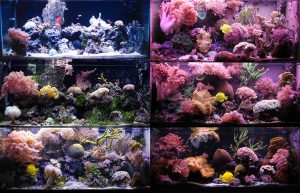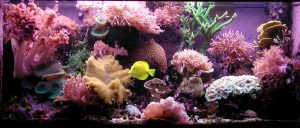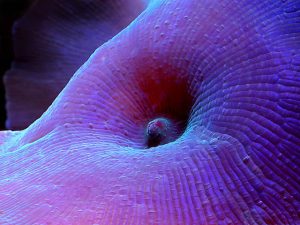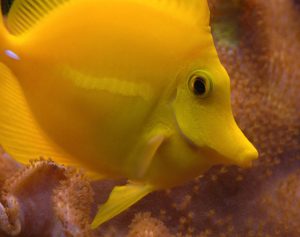I have set up several reef tanks. Currently, 5 marine tanks are placed in various rooms around my house. I find the difference between the tanks a source of amazement. Each has its individual personality in terms of behavior of the organisms that dominate over time. The 75 gallon featured in this article is the first tank I established. It has been the main source of material for all of my other tanks. The procedures I used on this tank are the most conventional. This may be the reason the tank has remained the most stable and productive of my tanks.
One of the goals of this tank was to keep it inexpensive. I initially spent about a year deciding what size tank to set up. I wanted to place it in the dining room. I wanted as large a tank as possible without dominating the room. Because of its public location there were some constraints—it had to be self contained and look good. While, my son thought that large skimmers were cool, my wife was less than enthusiastic about a large skimmer placed next to the aquarium. There were endless possibilities. Finally, I was offered a free, beat up, 75 gallon with pine stand. I thought I would begin with this and later upgrade the tank. Now I realize that there is so much effort in setting up a tank that I will not upgrade until some disaster hits the 75 gallon. Anyway, by painting the stand and the plastic strips on the tank to match the paint in the room, it looked pretty good and fit in with the dining room. I did not have to make a decision about what tank to buy. I was ready to begin.

Fig. 2) Complete system in dining room. The empty wine bottles on the top are used to drip Kalkwasser and makeup water. The small volume prevents overflow if (when) the float valve fails.
Given the theme that this was a starter tank, it made little sense to spend a lot on the associated mechanical systems. The tank came with a wet-dry filter. I removed the media and used it as a sump. I built the lights and calcium reactor myself. I purchased a VHO ballast, pumps, protein skimmer, mechanical float valve, heater, fan, and temperature controller. Total spent on hardware was well under $1000.
Another goal was to keep the tank robust and easy to maintain. There are many reasons to set up a reef tank. I am personally fascinated with balanced ecosystems. I take great pleasure in watching the organisms thrive and reproduce. The less intervention that is needed–the happier I am. In general, I favor biological solutions compared to technological ones. I am unwilling to undertake special feeding regimes for a particular organism. Others are interested in keeping unusual, in some cases expensive, organisms. I am quite content to grow the most common corals. For example, my favorite coral, the Colt Coral, is also one of the easiest to grow (Fig. 3). Its dominating size has made it a focal point in the tank. Another favorite is the Green Bali Acropora (Fig. 4). It has shown spectacular growth over time. I estimate that I have given away, killed, or discarded about 5 times the volume of coral shown in Fig. 4.
I established the tank in the fall of 1998. I purchased 80 lbs of Fiji live rock and waited several months before adding my first corals. Because I lacked the confidence that I could keep coral alive, and also, because this was a “cheap starter tank,” I purchased small frags to start. These corals came from frags exchanged at out local club (Chicagoland Marine Aquarium Society) and frags raised at two local stores (A Splash of Life and Harbor Aquatics). The first photo (Fig. 5a) shows the aquarium after 7 months. The corals that later dominate my tank are all present in this photo. They include: Colt, Brain, Green Bali Acropora, Mushrooms, Euphyllia sp., Caulastrea sp., Tonga Yellow Leather, and Pumping Xenia.

Fig. 3) A pair of clowns have made the large colt coral their home. They spawn regularly on one of the aquarium walls near the coral.
The picture also shows a Scarlet Dendronepthia that was sold to me by a local store. They assured me it was photosynthetic. You might notice it is not present in the later pictures. After one year I was confident I could keep corals alive and started to purchase larger and more expensive specimens. In general, they did not fare as well as the local frags, and have either died or been moved to other aquariums. In the first year I also purchased my first fish. They were locally raised clown fish ( Amphiprion ocellaris ). They can be seen in Fig. 5b and 6b. In Fig. 5b they had not yet discovered that a Colt Coral could make a satisfying home, but rather hovered over the Brain coral. My other fish, a Yellow Tang ( Zebrosoma flavescens ), and a locally raised Banggai Cardinalfish, were added at about 2 years.
It is apparent in Fig. 5, that by the third year, the tank is mature. The basic appearance of the tank has not changed much since then. Many of the corals had reached the largest size that I could maintain in this aquarium. The Colt, mushrooms, and Pumping Xenia have to be pruned back to prevent damage to the other organisms. The Euphyllia sp., Caulastrea sp., and Montipora capricornis are limited in size by the fragility of their skeletons. They periodically break and must be restarted with the frags. The SPS corals would grow large, shade their base, and then catch white band disease. I used large cuttings from the dying corals to reestablish the colonies. I now prophylactically chop them up for frags before they self- destruct. Some SPS corals have been removed because I could not maintain attractive large colonies and they were spreading like weeds to undesired locations. Montipora digitata, Fire Coral, and Pocillopora damaicornis fall in this category. Some corals, Turbinaria sp., Brain, Porites sp., Tonga Yellow Leather,_ Cynarina sp.,_ Ricordea florida, and Zooanthids have slowly grown over time and I have not yet had to face reducing their size.
This 75 gal tank has been my favorite tank to photograph. The combination of daylight and actinic bulbs provides good color, particular my digital cameras. Figs. 4 and 6 show my favorite photographs taken of this tank.

Fig. 4) Green Bali Acropora. In this photo the coral is encrusting the back wall of the tank, giving the overall green color to the photo. Experience has shown me that when it encrusts the back wall it is particularly susceptible to shading followed by white band disease. I no longer allow the coral to encrust the back wall.
In summary, this tank has been very rewarding. While spending little money, at least in reef aquarium terms, I think I have achieved a very attractive tank. It remains my favorite tank and the most photographed. It is quite robust. I highly recommend that someone setting up their first reef tank, use small frags taken from other hobbyists. They tend to be hardy and quickly grow into the space available. However, in spite of the rapid growth and health of the corals in this tank, I have not fully achieved the goal of an easily maintained tank. The tank requires weekly maintenance. The balance of the organisms in the tank is constantly changing and requires my intervention keep a mixture of organisms.
Filtration
- Protein skimmer – Top Fathom 100
- 80 lbs of live rock — I started with 80 lbs of Fiji rock. Since then approximately half has been removed to start other aquariums. I replaced the rock with dead coral skeletons or aragonite rocks. The dead rock is now indistinguishable from the Fiji rock.
- 1″ live sand

Fig. 5) History of the tank. Left column, from top, age of tank: a) 0.6, b) 1.2, and c) 2.5 years. Right column from top: d) 3.0, e) 4.1, and f) 5.1 years. The different colors are a result of using different cameras, the lighting has remained constant. All the prominent organisms shown in the last 2 years appear as frags in the first photo.
Lighting
- 2 x 110 watt VHO, daylight
- 2 x 110 watt VHO, Actinic
- 1 40 watt NO florescent, daylight
Lighting Schedule
- VHO 9 hours
- NO 14 hours – allows viewing tank during dinner without blinding the diners
Calcium and alkalinity (no other additives used)
- homemade Calcium reactor
- Kalkwasser is used for the makeup water
Water Circulation
- sump with 700gph pump—overflow in rear center, returns at both ends
- 2 powerheads—both at one end of the tank to provide a clockwise flow in the SPS zone (right side of tank)
- no additional circulation in the soft coral zone (left side of tank)
Cooling
- 3 inch fan in hood—Its purpose is to keep bulbs cool and prolong their life. It is turned on with the VHO lights.
- 4 inch fan blowing across the water—It keeps the tank cool by evaporation. It is under servo control to maintaine the temperature at 79 ±1 °F.
Maintenance
- 5 g water changed weekly
- corals pruned as needed
- glass cleaned weekly
Water Parameters:
- Calcium 400-450 ppm
- ALK 2.5-3.0 mEq/l
- S.G 1.025
- Temp 78-80 °F
- Nitrate and Phosphate un-measurable with LaMotte test kits
Inhabitants Corals
- SPS – Green Bali Acropora, Acropora digitifera, Hydnophora sp., Porites sp., Montipora sp., Pavona sp., Tubinaria sp.
- LPS – Euphyllia sp., Cynarina sp., Caulastrea sp., Brain
- Soft – Colt, Tonga Yellow Leather, Sarcophyton sp., Zooanthids, Mushrooms, Pumping Xenia, Ricordia florida
Fish:
- Yellow Tang ( Zebrosoma flavescens, 3.5 years)
- 2 Clownfish ( Amphrion percula, 4.5 years, tank raised Chicago)
- Banggai Cardinalfish (3 years, tank raised Chicago)
Mobile Inverts—clean up crew:
- Astrea snails
- blue leg hermits
- mini brittle stars
- pink bristle worms
- large bristle woms from live rock
Problems
- White Band Disease in large SPS colonies
- various problem alga
















0 Comments